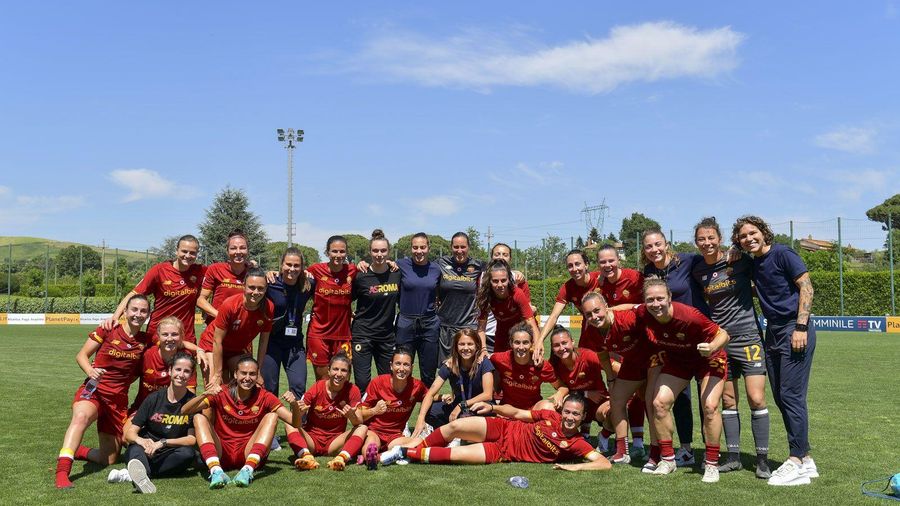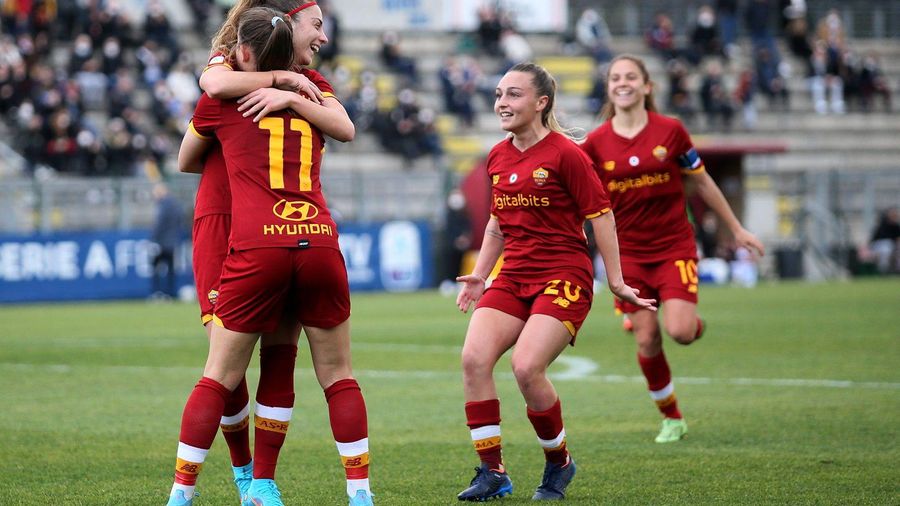

Roma Women enjoyed a positive 2021-22 season, exceeding the expectations of some outside observers to finish as runners up in both Serie A Femminile and the Coppa Italia.
Their league standing was their best-ever, enabling them to qualify for the Champions League for the first time in their history.
And although the season ended with a feeling of being so close to retaining their cup, yet without success, upon reflection the past 12 months can only be seen as a phase of major progress.
Under new coach Alessandro Spugna – who will continue to lead the side in 2022-23 – Roma built on the foundations of what Betty Bavagnoli had set up before. In the process, they became a force to be reckoned with, showing increased levels of competitiveness, especially over the second half of the campaign.
There were several ways in which they adapted and improved their game – as individuals and a collective – in order to set new heights for the club.
Increased tactical flexibility
After mainly favouring a 4-3-3 or 4-2-3-1 formation during the reign of Bavagnoli – shapes that are not too distinctly different, but could interchange depending on the needs of each game – Roma showed further adaptation after Spugna took the reins.
Spugna started out with a 4-3-3 system, like he had favoured for Empoli the season before. Over time, though – and partly out of necessity – he changed the way Roma set up.
For a good portion of the season, Roma switched to using a back three. Often there would be four bodies across midfield and three up front, but sometimes Spugna would pair two strikers together instead.
The change in system became especially important in the aftermath of Allyson Swaby’s departure from the club in January. Deprived of their longest-serving centre-back, Roma had to adapt the composition of their rear-guard.
For example, captain Elisa Bartoli – naturally a full-back – spent several games within the back three, and sometimes even played centrally when Roma reverted to a four. Fellow full-back Lucia Di Guglielmo could also slot in as part of a three when required.
Out wide, the likes of Annamaria Serturini and Emilie Haavi became wing-backs, as opposed to wingers. Especially in the case of the former – who is Roma’s record scorer in women’s football – it meant an adaptation and development of more defensive aspects, although neither lost their licence to get forward.
As a result, on the occasions Roma went back to a 4-3-3 or similar, they were still ready to contribute from the wings further forward.
Roma had various styles of play across the season, but their flexibility showed how their intelligence was increasing tactically.
Mentality to put together an unbeaten run
The fact they kept up their form while learning different tactical nuances, while passing through some difficult spells of fixtures, was testament to the mentality that was also growing within them.
After winning the 2020-21 Coppa Italia under Bavagnoli, Roma had proven they could compete at the top level. What followed in 2021-22 after Spugna’s succession made good use of that inherent assurance of being able to challenge the best.
When the Serie A fixtures were released for the 2021-22 campaign, Roma were challenged with the task of facing Inter, Juventus, Milan and Sassuolo – the other teams who would comprise the top five by the end of the season – consecutively, twice.
October proved a difficult obstacle to pass, as Roma lost to Juventus, drew with Milan and lost to Inter, but then beat Sassuolo. There was still some way to go, but little was it realised at the time, they were already on their way.
Incidentally, the loss to Inter turned out to be the last one Roma suffered in Serie A that season. They would go unbeaten from their remaining five fixtures before Christmas, before successfully navigating all 11 games of the second half of the season without blemish.
Accordingly, across February and March, this time Roma beat Inter, drew with Juventus and Milan, and enjoyed a convincing victory over Sassuolo.
By this point, Spugna’s side were in full momentum and in control of their destiny. Unperturbed by the stature of side they were facing, Roma refused to be slowed down as their dream of qualifying for the Champions League became more and more tangible. It was ultimately realised.
Introducing more talent mid-season
Another factor behind Roma’s refusal to lose steam as the season progressed was their identification and acquisition of new players who could help them strive for their goals.
The season before, they had seen what an impact Elena Linari had made after arriving partway through. Hence, they took the opportunity to bolster their ranks again.
As many as five players were brought in over the winter months: winger Haavi, attacking midfielder Milica Mijatovic, striker Sophie Roman Haug, defender Beata Kollmats and backup goalkeeper Emma Lind.
Of the quintet, the player with the biggest impact was Haavi. The Norwegian adapted seamlessly to a wing-back role and did not take long to begin contributing to goals.
Indeed, between January and February, she scored in four consecutive games, something only two of her new teammates had done for the club before.
To a lesser extent, Mijatovic and Roman Haug were useful in their own ways. The former scored 38 seconds into the derby on the final day of the league season; although she has since departed, that certainly will not be forgotten in a hurry.
That was also a game in which the latter found the net (for the fourth Serie A game in a row, despite usually being a substitute), showing promise for what is to come.
Kollmats and Lind could also be judged as helpful rotation options, bringing their own experience to the side.
Roma gave themselves new energy by bringing in useful squad members midway through the campaign, providing a boost as they strived for the finishing line.
Relentless goalscoring approach
As their impressive form continued, Roma were relentless in front of goal. For example, their last two home games of the season were particularly high-scoring affairs.
First, against Verona in April, Roma won 7-1 – after putting five past the same opponents in the reverse fixture – to match their record league win. One month later, they would better it by defeating Sampdoria 8-0.
It was the biggest win any side recorded in Serie A Femminile that season, in which perhaps unsurprisingly Roma ended as the league’s highest scorers. Their tally of 60 goals from their 22 matches was their best-ever return, which certainly helped them setting their record points total so far as well.
Some of the best goals along the way were Andressa Alves’ looping effort from wide against Napoli in September, Paloma Lazaro’s backheel flick against Verona in November, Benedetta Glionna’s derby-winning free kick in December and Valeria Pirone’s lob against Lazio in May.
Overall, there were a variety of finishes – several coming after good team moves – which were representative of the confidence Roma were gaining.
Never letting games get away from them
In contrast, they were equally effective at the other end of the pitch. Only champions Juventus conceded fewer goals than the 18 Roma let in throughout the 2021-22 Serie A Femminile season.
Roma were able to keep that column of the table low thanks to – again – aspects of their mentality. Becoming ever more competitive against sides of any stature, they were never beaten by more than one goal.
On only one occasion did they fall behind by two goals, in January’s Supercoppa Italiana semi-final defeat to Milan, but they reduced the deficit in that instance (albeit not by enough). In general, they were always attempting to claw their way back into the few games that turned against their favour to start with.
As stated, Roma’s application against bigger sides – although still having some way to go – showed signs of improvement. Towards the end of the season, they came from behind to claim draws against Juventus and Milan – the teams that finished either side of them in first and third respectively.
The next step will be for Roma to perhaps turn some of those draws into wins, but their increasing competitive nature can set them up well.
Likewise, their upcoming Champions League campaign – which will begin with an intriguing tie against Glasgow City – should be a test of their resolve against other competitive sides, most of whom they will not have come across before.
With that in mind, steps are already being taken to bolster the squad with players of appropriate experience, such as former Bayern Munich defender Carina Wenninger, who should add further strength at the back.
The squad will have to adjust to the new levels quickly, with the challenge against Glasgow City on the horizon in August. The Scottish side have some European pedigree, so will be an interesting obstacle to pass before Roma can think of playing Paris FC or Servette – and anyone else beyond that.
With the way they developed over the past 12 months, though, Roma can take belief that they are capable of this step up into new territory. Some positive experiences are behind them from what was their best season yet – and now it is time for a new chapter.

 Tickets
Tickets
 Shop
Shop








































